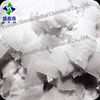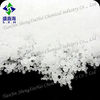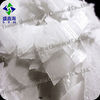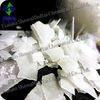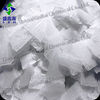- Contact Person : Mr. Zhang Jason
- Company Name : Tianjin Shengxinhai Chemical Co., Ltd.
- Tel : 86-22-24815666
- Fax : 86-22-24398887
- Address : Tianjin,Tianjin,Baishaling, Yongxing Village, Junliangcheng Town
- Country/Region : China
- Zip : 300300
Manufacturer!!! On Textile Industry and Water Treatment Industry Caustic Soda Flakes 99% MI Industry grade (REACH SGS BV)
ITEMS | STANDARD | RESULTS |
NaOH % | ≥99.0 | 99.30 |
Na2CO3 % | ≤0.90 | 0.40 |
NaCl% | ≤0.15 | 0.03 |
Fe2O3% |
≤0.005 | 0.002 |
1. Professional Manufacturer with best price2. We can accept BV SGS ISO90013.14 years experience4.Within 15 days shipment.
Sodium hydroxide is the principal strong base used in the chemical industry. In bulk it is most often handled as an aqueous solution, since solutions are cheaper and easier to handle. Sodium hydroxide, a strong base, is responsible for most of these applications. Another strong base such as potassium hydroxide is likely to yield positive results as well.
56 % of sodium hydroxide produced is used by the chemical industry, with 25 % of the same total used by the paper industry. Sodium hydroxide is also used for the manufacture of sodium salts and detergents, for pH regulation, and for organic synthesis. It is used in the Bayer process of aluminium production.[1]
Sodium hydroxide is used in many scenarios where it is desirable to increase the alkalinity of a mixture, or to neutralize acids.
For example, sodium hydroxide is used as an additive in drilling mud to increase alkalinity in bentonite mud systems, to increase the mud viscosity, and to neutralise any acid gas (such as hydrogen sulfide and carbon dioxide) which may be encountered in the geological formation as drilling progresses.
In the same industry, poor quality crude oil can be treated with sodium hydroxide to remove sulfurous impurities in a process known as caustic washing. As above, sodium hydroxide reacts with weak acids such as hydrogen sulfide and mercaptans to give the non-volatile sodium salts which can be removed. The waste which is formed is toxic and difficult to deal with, and the process is banned in many countries because of this. In 2006, Trafigura used the process and then dumped the waste in Africa
Sodium hydroxide was also widely used in making paper. Along with sodium sulfide, NaOH is a key component of the white liquor solution used to separate lignin from cellulose fibers in the Kraft process. It also plays a key role in several later stages of the process of bleaching the brown pulp resulting from the pulping process. These stages include oxygen delignification, oxidative extraction, and simple extraction, all of which require a strong alkaline environment with a pH > 10.5 at the end of the stages.
Sodium hydroxide is frequently used as an industrial cleaning agent where it is often called "caustic". It is added to water, heated, and then used to clean the process equipment, storage tanks, etc. It can dissolve grease, oils, fats and protein based deposits. It is also used for cleaning waste discharge pipes under sinks and drains in domestic properties. Surfactants can be added to the sodium hydroxide solution in order to stabilize dissolved substances and thus prevent redeposition. A sodium hydroxide soak solution is used as a powerful degreaser on stainless steel and glass bakeware. It is also a common ingredient in oven cleaners.
A common use of sodium hydroxide is in the production of parts washer detergents. Parts washer detergents based on sodium hydroxide are some of the most aggressive parts washer cleaning chemicals. The sodium hydroxide based detergent include surfactants, rust inhibitors and defoamers. A parts washer heats water and the detergent in a closed cabinet and then sprays the heated sodium hydroxide and hot water at pressure against dirty parts for degreasing applications. Sodium hydroxide used in this manner replaced many solvent based systems in the early 1990s[citation needed] when trichloroethane was outlawed by the Montreal Protocol. Water and sodium hydroxide detergent based parts washers are considered to be an environmental improvement over the solvent based cleaning methods.
Sodium hydroxide is used in the home as a drain cleaning agent for clearing clogged drains, usually in the form of a dry crystal or as a thick liquid gel. Sodium hydroxide saponifies the triglycerides found in fat into water soluble fatty acid salts and hydrolyzes the amide bonds in protein, such as those found in hair. These reactions are sped by the heat generated when sodium hydroxide and the other chemical components of the cleaner dissolve in water. Such drain cleaners and their acidic versions are highly caustic and should be handled with care
Sodium hydroxide is used in some relaxers to straighten hair. However, because of the high incidence and intensity of chemical burns, manufacturers of chemical relaxers use other alkaline chemicals in preparations available to average consumers. Sodium hydroxide relaxers are still available, but they are used mostly by professionals.
A solution of sodium hydroxide in water was traditionally used as the most common paint stripper on wooden objects. Its use has become less common, because it can damage the wood surface, raising the grain and staining the colour.Solid sodium hydroxide or solutions of sodium hydroxide
Cleaning agent
Main article: Cleaning agentSodium hydroxide is frequently used as an industrial cleaning agent where it is often called "caustic". It is added to water, heated, and then used to clean the process equipment, storage tanks, etc. It can dissolve grease, oils, fats and protein based deposits. It is also used for cleaning waste discharge pipes under sinks and drains in domestic properties. Surfactants can be added to the sodium hydroxide solution in order to stabilize dissolved substances and thus prevent redeposition. A sodium hydroxide soak solution is used as a powerful degreaser on stainless steel and glass bakeware. It is also a common ingredient in oven cleaners.
A common use of sodium hydroxide is in the production of parts washer detergents. Parts washer detergents based on sodium hydroxide are some of the most aggressive parts washer cleaning chemicals. The sodium hydroxide based detergent include surfactants, rust inhibitors and defoamers. A parts washer heats water and the detergent in a closed cabinet and then sprays the heat
Manufacturer!!! On Textile Industry and Water Treatment Industry Caustic Soda Flakes 99% MI Industry grade (REACH SGS BV)

